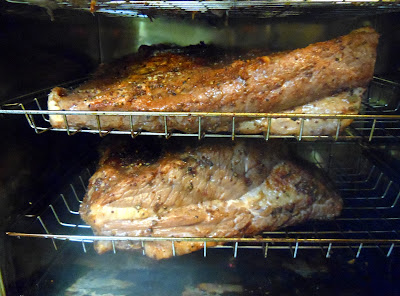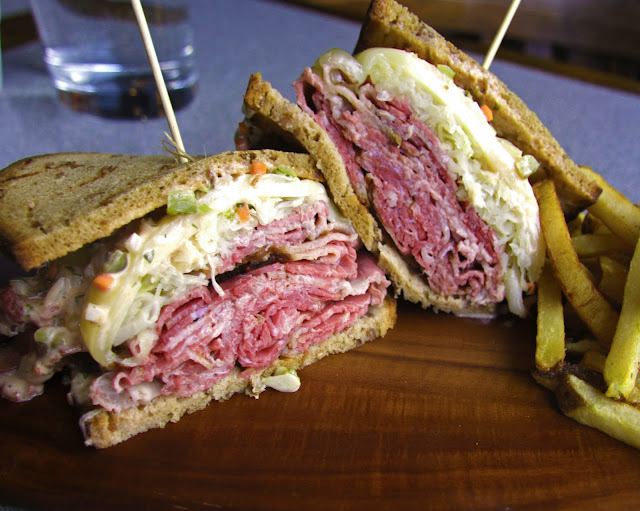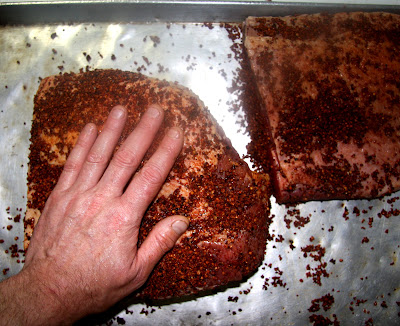Before I was a chef, certain food was easily understood. Roast beef was a cut of beef roasted. Boiled carrots, grilled fish needed no explanation. Other foods were a mystery. Pastrami and corned beef in particular were fascinating to me. It's delicious, but what is it? It looks like meat but is salty ,sweet, spicy, and a strange red colour no matter how long you cook it. My mom would buy it sometimes in these little boil in the bag portions from Shopsy's. It was a treat and I loved it. As a teenager if we were at a movie or something I would pick a Druxy's deli sandwich over a Big Mac whenever I could. In 1986 I moved to Kensington market and started cooking school. I began to learn things. I began to understand deli.
 |
| Kensington Market through the ages |
 |
| Old Kensington Market |
 |
| Some delis in Toronto |
So what is pastrami, and why is it associated with the North American Jewish community? Pastrami is a variation on the Romanian word pastramă which indicates something that is preserved. Some of the first Jewish immigrants to New York were from Romania and they brought the recipe for this cured and smoked meat with them. In Europe this process could be applied to lamb, pork, goose, or almost any meat. It was a natural way to preserve foods before refrigeration. In America beef navel or brisket was a cheap option and the modern Americanized pastrami recipe was developed. A common occupation of Jewish immigrants was to sell prepared foods from pushcarts, and selling pastrami in a sandwich was a logical and popular choice.
 |
| New York pushcart at the turn of the century |
Whether my recipe for pastrami is NewYork style pastrami or Montreal smoked meat style is debatable. I use the whole brisket as in Montreal, but the brine is sweeter like the New York style. Maybe it's Toronto style pastrami. I don't know, but its good.
 |
| brisket brined for 11 days |
For pastrami a dry rub is applied to the corned beef and it is smoked for several hours. The traditional rub for pastrami is coriander seed, black pepper and garlic. I added black mustard seed, brown sugar and smoked paprika to my rub.
 |
| pastrami brisket smoking |
 |
| spices for pastrami rub |
The finished product was great. Maybe a bit crumbly and salty at the thin end of the brisket, but in general it sliced and tasted as good as pastrami at any deli I've been to.
 |
| rachel sandwich with homemade pastrami |
http://www.toromagazine.com/lifestyle/food/1dbbd7c7-49a4-9684-05b3-943d35b762c0/Caplanskys+Smoked+Meat+Poutine/
Recipe For Homemade Pastrami
The Meat
1 whole beef brisket cut in half at midpoint.This is for ease of storage.
The Brine:
8L water
3 cups kosher salt
4 tsp sodium nitrate
1 cup brown sugar
20 garlic cloves
1 cup pickling spice mix
10 cloves
10 piece star anise
Bring the above to a boil in a pot and let cool. Place whole brisket cut in half in a non-reactive plastic or stainless steel container and cover completely with brine. The beef may float so weigh down with some plates. refrigerate for 9 to 11 days. 9 will do, but I feel the extra time gives it a more authentic texture. rinse the brisket thoroughly and apply the dry rub liberally.
Dry Rub:
In a food processor grind
1 cup coriander seed
½ cup black peppercorns pre-cracked
½ cup black mustard seed
¼ cup smoked Spanish paprika
½ cup brown sugar
6 clove garlic
Smoking
This part is a bit tricky because it depends on your smoking method. I used a Bradley smoker with apple briquettes and smoked the brisket for three hours then slow roasted at 180°F for 8 hours. If your using real wood you might be able to smoke it the whole time. The key to me is long and slow. Try to keep the temperate around 200°F. The smoke flavour should enhance the meat not over power it.
If your doing this at home and can't store or smoke a whole brisket. Try to cut down the portions. Remember to keep the ratio of water to salt to sodium nitrate the same though, and be wary of the brining time for a smaller piece. It may vary by days!
Hopefully you will have as much luck as I did











